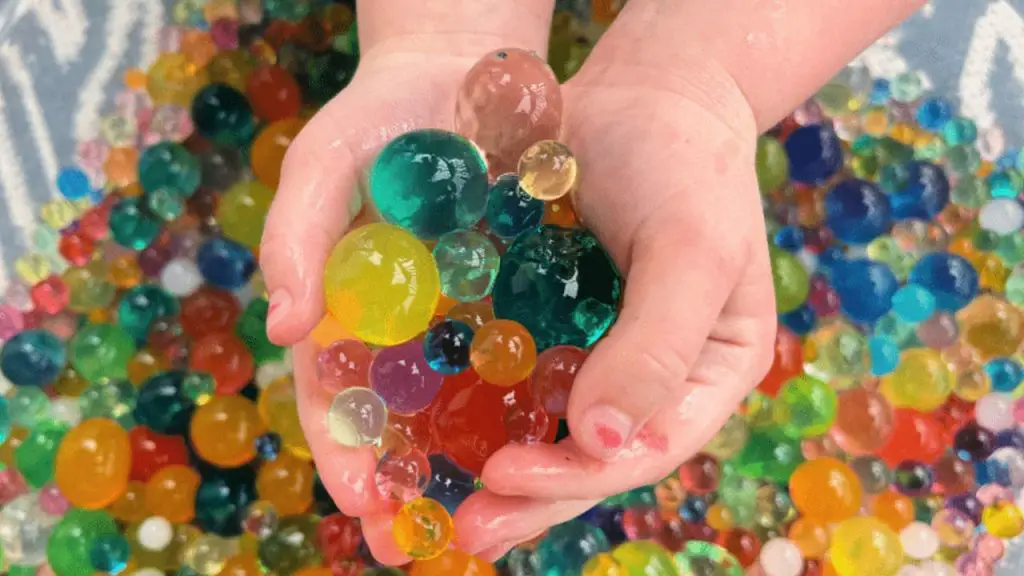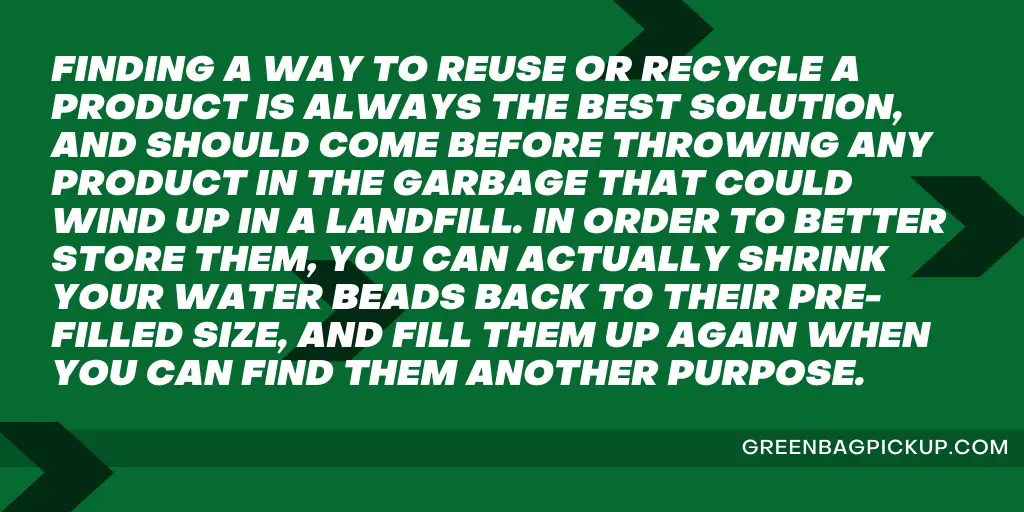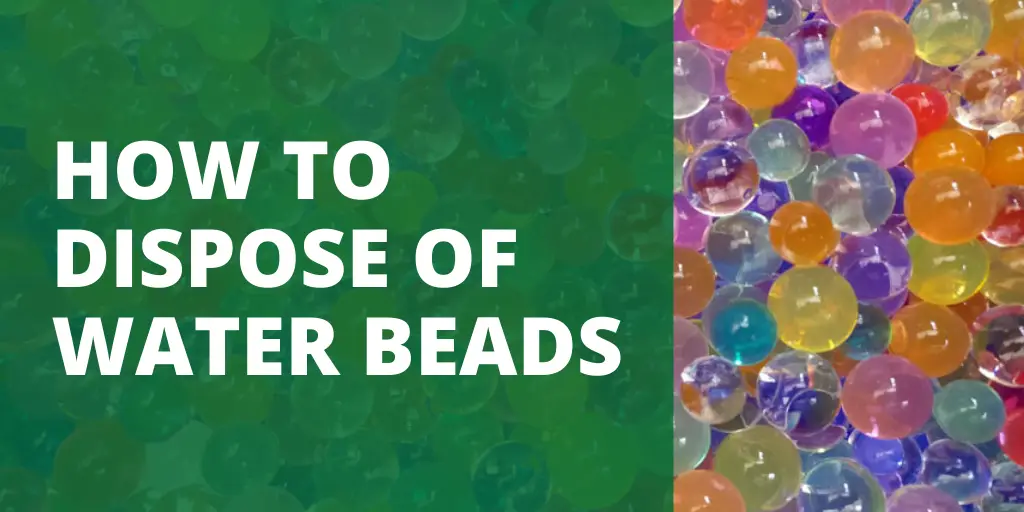Water beads are small, non-edible beads (roughly the size of a blueberry) and are often used as a decorative addition to your home and for floral arrangement designs. There are also water beads marketed towards children (such as Orbeez), that are used for various arts and crafts.
They are made of a combination of water and water-absorbing polymer, and fill up and expand like a sponge when they don’t already come pre-soaked.
Although water beads can be both entertaining and useful, how do you safely dispose of them when they’ve fulfilled their purpose?
We’re going to look at some of the effective ways to safely dispose of water beads, so you can avoid causing a major plumbing or safety issue.
Methods for Disposing of Water Beads

1. Throwing them in the trash
When throwing water beads in the trash, it is important to ensure they are completely dry. They can create moisture and potentially cause odors or mold growth in the garbage if they are still wet.
You can dry them by spreading them flat and leaving them in a well-ventilated area for a few days. Alternatively, you can use a paper towel to absorb any excess moisture.
It is also important to note that some trash collection services may have specific requirements for disposing of water beads.
For example, they may need to be placed in a particular bag or container, so it is best to check with your local waste management agency for more information.
Simon Books of Moms.com tells us why you should never flush water beads or pour them down the train when disposing of them:
“However, since Orbeez can swell up to 150 times their original size when in water, throwing them down a sink or toilet is not a good idea. When Orbeez get in contact with water, they will swell up and cause possible clogging.
Learning just how much plumbing problems Orbeez can cause from experience can be painful. Therefore, you need to be careful not to flush them down any drain in your house.”
2. Composting
Composting is a great way to dispose of water beads if you have a compost bin. However, since water beads can take a long time to decompose, it is important to break them up into smaller pieces first to help them break down faster.
You can do this by putting them in a blender or food processor or using a mortar and pestle to crush them into smaller pieces.
The use of water beads is not appropriate for every composting system. Some compost systems may be unable to break down the polymer material of water beads.
Therefore, it is recommended that you refrain from using water beads in your compost if you are unsure whether your compost system can handle them.
3. Add Them to Your Soil
Adding water beads to your plant soil is a fantastic way of reusing water beads once they’ve served their purpose!
Although water beads are certainly not safe for consumption, they are biodegradable and contain the same polymer clay that is likely already in your soil.
Parenting Chaos tells us how they prefer to use this method for recycling their water beads:
“When we are done playing with water beads and aren’t going to store them, I crumble them up and add them to the soil of our potted plants.
The polymer that is used in water beads is also used in a lot of bagged potting soil.”
4. Shrink and Reuse Them
Finding a way to reuse or recycle a product is always the best solution, and should come before throwing any product in the garbage that could wind up in a landfill.
In order to better store them, you can actually shrink your water beads back to their pre-filled size, and fill them up again when you can find them another purpose.
Waterbeads.co gives us one option for reusing your water beads instead of throwing them out:

Safety Tips and Precautions
1. Wear Gloves
When handling water beads, always wear gloves to prevent skin irritation. Water beads can sometimes contain chemical additives that can cause skin irritation or allergic reactions in some people.
2. Avoid Disposing of Water Beads in Bodies of Water
Water beads can harm aquatic life if disposed of in bodies of water. They can be mistaken for food by fish and other marine animals and cause blockages in their digestive systems.
Therefore, it’s important to avoid disposing of water beads in bodies of water.
3. Use a Plastic Bag
If you are disposing of many water beads, consider using a plastic bag to contain them and prevent them from scattering.
This will make it easier to dispose of and prevent them from entering the environment.
4. Contact Your Local Waste Management Agency
If you need help with how to dispose of water beads, contact your local waste management agency for guidance.
They can provide information on properly disposing of water beads in your area and answer any questions.
Benefits of Disposing of Water Beads Safely
Once upon a time, a little girl named Lily loved playing with water beads. She loved how they felt squishy and slimy in her hands and how they looked when they glistened in the sunlight.
But one day, Lily learned that disposing of water beads unsafely could harm the environment and its creatures. She didn’t want to be responsible for hurting any of her furry or scaly friends, so she decided to dispose of her water beads safely.
And boy, was she glad she did! Not only did she feel good about doing the right thing, but she also discovered some unexpected benefits of disposing of water beads safely.
For starters, her trash smelled better. Before, when she threw her water beads in the garbage while still wet, they would create a lot of moisture and start to smell funky afterward.
But now that she ensured they were completely dry before throwing them away, her trash smelled much better!
Plus, her mom was happy she wasn’t contributing to landfill leachate. Lily didn’t know what that meant.
Still, her mom explained that when things that aren’t biodegradable (like water beads) are buried in a landfill, they can create a toxic liquid called leachate that can contaminate the environment. Yuck! Lily was happy to know she was doing her part to help prevent that.
And to top it all off, Lily used her creative skills to find new ways to reuse her water beads. She started using them as decorations in her room and even found ways to turn them into cool art projects. Who knew that being environmentally responsible could be so much fun?
So the next time you find yourself with a handful of water beads, remember Lily’s story and the benefits of disposing of them safely.
You will do your part to protect the environment and might even discover some unexpected blessings. And you might even find a new hobby or two!
The Bottom Line
Water beads are a popular decoration that can be safely and responsibly disposed of by throwing them in the trash, composting, or recycling.
It’s important to take safety precautions when handling and disposing of water beads, including wearing gloves and avoiding them in bodies of water.
Following these tips and precautions, you can safely dispose of water beads and prevent them from harming the environment.
FAQs
Are water beads biodegradable?
No, water beads are not biodegradable. They are made of a polymer material that does not break down naturally in the environment.
Do water beads dissolve outside?
Water beads do not dissolve outside. They will only shrink and dehydrate over time when exposed to sunlight and air.
Are water beads toxic to humans?
Water beads are non-toxic but hazardous to humans. They can be life-threatening in some situations.
Additional Posts:

